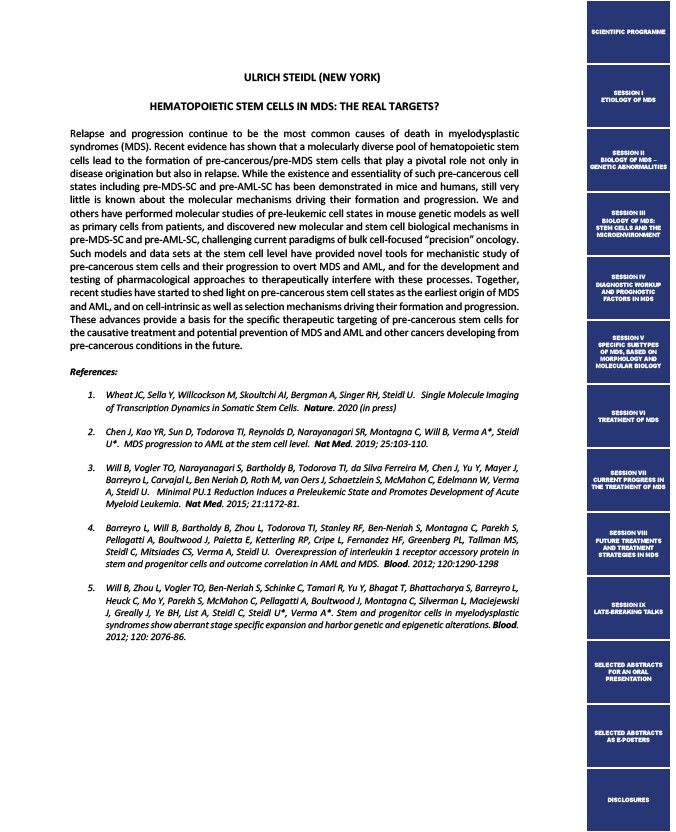
ULRICH STEIDL (NEW YORK)
HEMATOPOIETIC STEM CELLS IN MDS: THE REAL TARGETS?
Relapse and progression continue to be the most common causes of death in myelodysplastic
syndromes (MDS). Recent evidence has shown that a molecularly diverse pool of hematopoietic stem
cells lead to the formation of pre-cancerous/pre-MDS stem cells that play a pivotal role not only in
disease origination but also in relapse. While the existence and essentiality of such pre-cancerous cell
states including pre-MDS-SC and pre-AML-SC has been demonstrated in mice and humans, still very
little is known about the molecular mechanisms driving their formation and progression. We and
others have performed molecular studies of pre-leukemic cell states in mouse genetic models as well
as primary cells from patients, and discovered new molecular and stem cell biological mechanisms in
pre-MDS-SC and pre-AML-SC, challenging current paradigms of bulk cell-focused “precision” oncology.
Such models and data sets at the stem cell level have provided novel tools for mechanistic study of
pre-cancerous stem cells and their progression to overt MDS and AML, and for the development and
testing of pharmacological approaches to therapeutically interfere with these processes. Together,
recent studies have started to shed light on pre-cancerous stem cell states as the earliest origin of MDS
and AML, and on cell-intrinsic as well as selection mechanisms driving their formation and progression.
These advances provide a basis for the specific therapeutic targeting of pre-cancerous stem cells for
the causative treatment and potential prevention of MDS and AML and other cancers developing from
pre-cancerous conditions in the future.
References:
1. Wheat JC, Sella Y, Willcockson M, Skoultchi AI, Bergman A, Singer RH, Steidl U. Single Molecule Imaging
of Transcription Dynamics in Somatic Stem Cells. Nature. 2020 (in press)
2. Chen J, Kao YR, Sun D, Todorova TI, Reynolds D, Narayanagari SR, Montagna C, Will B, Verma A*, Steidl
U*. MDS progression to AML at the stem cell level. Nat Med. 2019; 25:103-110.
3. Will B, Vogler TO, Narayanagari S, Bartholdy B, Todorova TI, da Silva Ferreira M, Chen J, Yu Y, Mayer J,
Barreyro L, Carvajal L, Ben Neriah D, Roth M, van Oers J, Schaetzlein S, McMahon C, Edelmann W, Verma
A, Steidl U. Minimal PU.1 Reduction Induces a Preleukemic State and Promotes Development of Acute
Myeloid Leukemia. Nat Med. 2015; 21:1172-81.
4. Barreyro L, Will B, Bartholdy B, Zhou L, Todorova TI, Stanley RF, Ben-Neriah S, Montagna C, Parekh S,
Pellagatti A, Boultwood J, Paietta E, Ketterling RP, Cripe L, Fernandez HF, Greenberg PL, Tallman MS,
Steidl C, Mitsiades CS, Verma A, Steidl U. Overexpression of interleukin 1 receptor accessory protein in
stem and progenitor cells and outcome correlation in AML and MDS. Blood. 2012; 120:1290-1298
5. Will B, Zhou L, Vogler TO, Ben-Neriah S, Schinke C, Tamari R, Yu Y, Bhagat T, Bhattacharya S, Barreyro L,
Heuck C, Mo Y, Parekh S, McMahon C, Pellagatti A, Boultwood J, Montagna C, Silverman L, Maciejewski
J, Greally J, Ye BH, List A, Steidl C, Steidl U*, Verma A*. Stem and progenitor cells in myelodysplastic
syndromes show aberrant stage specific expansion and harbor genetic and epigenetic alterations. Blood.
2012; 120: 2076-86.
SCIENTIFIC PROGRAMME
SESSION I
ETIOLOGY OF MDS
SESSION II
BIOLOGY OF MDS –
GENETIC ABNORMALITIES
SESSION III
BIOLOGY OF MDS:
STEM CELLS AND THE
MICROENVIRONMENT
SESSION IV
DIAGNOSTIC WORKUP
AND PROGNOSTIC
FACTORS IN MDS
SESSION V
SPECIFIC SUBTYPES
OF MDS, BASED ON
MORPHOLOGY AND
MOLECULAR BIOLOGY
SESSION VI
TREATMENT OF MDS
SESSION VII
CURRENT PROGRESS IN
THE TREATMENT OF MDS
SESSION VIII
FUTURE TREATMENTS
AND TREATMENT
STRATEGIES IN MDS
SESSION IX
LATE-BREAKING TALKS
SELECTED ABSTRACTS
FOR AN ORAL
PRESENTATION
SELECTED ABSTRACTS
AS E-POSTERS
DISCLOSURES